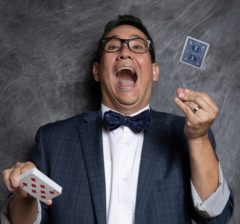One of my best friends (who is also an amazing performer) always says, “you’ve got to address the elephant in the room”. What he means is if there is something that the whole audience can see or is aware of that’s a distraction, you need to acknowledge it. When I perform at fairs, sometimes the “elephant in the room” is a literal elephant, other times it’s not.
A few weeks ago the backdrop to my stage was a row of porta-potty’s. It’s something that I needed to address, so here’s how I did it:
By addressing it immediately in the show, I got a big laugh. It also shows a bit of my personality, it shows that I’m fun and don’t take myself too seriously.
I talk a little bit about this in my interview with John Abrams on his podcast The Variety Artist that comes out on August 12th. I talk about a stage I performed on where to get onto the stage people from the audience physically had to leave the building and go around back. I also talk about how I addressed this problem. If you don’t listen to the podcast, you should give it a listen!
